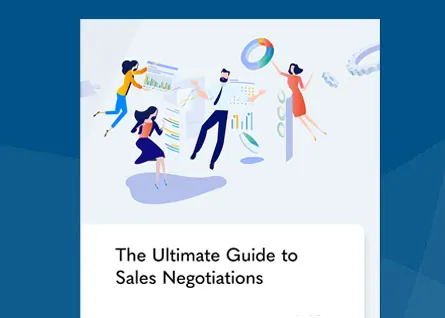How to Overcome Sales Objections with Clients

Listen to Nick and Justin on the Sales Reinvented Podcast
Janek Managing Partners Nick Kane and Justin Zappulla recently appeared on the Sales Reinvented Podcast to share their expertise on overcoming sales objections. Tune in to the Sales Reinvented Podcast now to hear Nick and Justin’s expert tips on mastering sales objections and taking your sales strategy to the next level.
Top Client Objections
One certainty for salespeople is that, at some point, they will handle objections. With the number of decision makers continuing to rise, sellers know they will likely encounter the sticky cog in the wheel, the lone holdout to a solution, even after everyone else gets on board. In deals ranging from the transactional to the complex and at any point in the sales process, chances are someone will scrunch their face, purse their lips, or straight up shake their head. While there can be countless reasons for this, top sellers know the value of patience, understanding, and empathy when confronting these protests, and here are ways to overcome the top-six client objections:

Client Budget Concerns
Without question, this is the number one reason clients raise objections. No matter how great the solution, the price doesn’t fit their budget, or they wish they had known the solution before funds were allocated. Of course, sellers know this is only partly true. Budgets are projections. They are not crystal balls, forecasted to certain outcomes. Therefore, it is the seller’s job to generate demand. Part of this is understanding the client’s personal and professional needs. When customers are bound by a budget, they’ll naturally base their range on its restrictions. But they may also use the old budget excuse for insisting on a lower price. Be a proactive seller, throwing out a number before the customer does. Budgets tend to open or stretch when buyers realize how their lives are improved by long-term, cost-effective solutions that add value, save money, and make themselves or their bosses look good.
Time
For some clients, it is never the right time to implement new solutions. How often have you heard, “If only the market wasn’t uncertain, or the Midwest storms didn’t set us back”? This can often be overcome with “What if?” questions, where sellers guide buyers to see the implications of both their actions and inaction. Like Ghosts of Christmas Past, sellers should show how the buyer’s life will be different in six months. For example, “What if you do nothing and another storm hits Davenport, your main distribution hub?” “Conversely, what if you implement our Platinum Package now and augment your other hubs with enough product to meet holiday demand?”
Competition
Another common objection stems from a competitor’s offer. After all, you are not the only game in town, and today’s clients are more knowledgeable than ever. Therefore, it is essential sellers know their competition’s offerings along with how they stack up against your own. Unless a product is so unique it stands alone and corners the market, many solutions are comparable. In this case, objections can be overcome with products that provide the greatest value. Here, sellers must know the specifications of their competitor’s offerings—how they’re made, how long they last, service and support—and contrast their own offerings to illustrate the best value.

Skeptical Clients
Some clients will balk at any perceived complication. This means you must overcome the domino effect of their thinking: new solutions bring new problems, learning curves, and a loss of productivity. For these clients, lead with empathy. After all, sellers too can be creatures of habit who resist technology or new ways of doing things, such as selling virtually. For skeptical clients, schedule demonstrations and walk throughs. If you yourself are not tech savvy or an expert with this product, bring in additional support to alleviate your client’s concerns. Remember, ease of use is a critical selling point, and buyers will appreciate any effort to keep it simple.
Lacking Decision Authority
Stop me if you heard this one. You impressed your contact and several others. They have fancy titles, like Director of This, VP of That, Senior So and So, and they are all enthusiastic about your solution. However, when it’s time to decide, none have real authority. They’ll tell you great things, like “If it were up to me…,” as their voice trails off. Of course, you should learn all decision makers during lead qualification, and it’s common for more to appear in discovery, but the best sellers check with their contacts throughout the sales process for decision makers with final authority. The sooner you can identify, engage, and impress these VIPs, the sooner you can shake hands and sign the paperwork.
Little Urgency from Clients
Sometimes, buyers don’t see the big picture. They recognize the potential of your solution, but they view it as a luxury. They don’t feel the urgency to move. Often, this stems from a value deficiency. Like patients who refuse to see a doctor unless something hurts, buyers must be prodded to act. Sellers should press the proverbial pain points to show buyers how much their inaction hurts their bottom line. Make them see the problem is not going away and may even get worse. For example, tell them, “If this was your loss in quarter three, the projected supply chain crisis could mean greater losses in quarter four.” Follow this with how their limited, up-front cost provides long-term value to both their bottom line and peace of mind.
Perhaps, if there’s a commonality in these objections, it would be fear: fear of wasting money or time, fear of inadequacy, not taking responsibility, making a mistake. This is compounded for managers and leaders whose decisions influence budgets and even staff. For sellers, understanding this can be key to success or failure. If objections derive from fear, then patience, understanding, and empathy can go a long way to overcoming them, and remind both buyers and sellers that the best defense is working with a trusted partner.
What to Consider with Client Objections
Despite what might be vast experience with negative responses, we’re not always used to hearing “no.” Literally, our mindset can make or break us in an objection situation. A sales professional with a positive mindset hears objections differently. Instead of letting a negative feeling take over, they might step back and watch the emotion go by. They also do a good job of keeping in mind that an objection is not a personal attack.
Capitalizing on Client Objections
Top sales professionals will take the helm and reframe the objection. They know that a sales objection can be an inroad for getting further on the path to understanding the customer’s needs, priorities, and values. Just having that interaction puts you in an excellent light. It shows you’re engaged; you’re listening; you’re empathetic; you’re right in there with the customer, getting at what kind of solution will suit them.
It may sound obvious, but when you’re selling, always remember that you’re engaged in a human interaction. Once you go into and occupy a negative emotion, in a sense you’re outside of that person-to-person interaction. Of course we can’t be expected to revamp our established behaviors and patterns overnight. But we can look at methods for letting the defensiveness and other emotional clouds drift on by.
If you have an emotional reaction to a customer objection, recognize the emotion, but then allow it to move on. Then take it a step further and empathize with the customer so that you can uncover the root of their objection. Subtracting your emotions from the equation frees you up to really engage the customer. Start by asking what their biggest concern is. Then actively listen to both what they say and what they don’t say. Listen to their pauses. Decode their non-verbal communication. Often the answers are in the spaces between what’s said. In other words, tune into the customer to understand their hesitation and to get closer to what their need is. Then you can start to really help them.
When you use objections as keys for unlocking what’s going on with the customer, you’re providing yourself with a chance to help the buyer see past their concerns and what they might, at least temporarily, perceive as obstacles. That puts you in a better position to uncover solutions.
Taking your bruised feelings out of the interaction actually increases the probability of a successful business relationship and laying the ground for long-term loyalty. And we can all agree: There’s not much to object to in that.
Overcoming Client Objections in 4 Steps
When you’re working with a client who is clearly on the fence about an investment, you have an opportunity to persuade and build a prosperous relationship among all parties. It could be that your initial pitch just needs a little extra support.
At Janek, we’ve had this experience several times over the years and learned how to navigate it to yield the best results. This proven methodology is also what we teach our clients as they pursue sales of their own products and services, and many have seen exceptional outcomes.
1. Empathize
The first step in any relationship is developing connections, and empathy is the fastest way to do so. Empathy puts you and the client on the same team, at the same level. It proves that no one is as suited to handling their concerns as you — because you have been there before.
The kind of empathetic touch many companies are looking for starts at home. Focus on leading with empathy and training your staff to expand their emotional depth. When you make this connection a natural part of your workplace, you’ll gain better results faster and develop more of those important relationships that continue far into the future.
2. Understand
Empathizing and understanding often go hand in hand. Where empathy is about making the emotional connection that creates strong bonds, understanding puts the logic behind it. It shows that you have the emotional maturity to understand what a client is experiencing and the industry expertise to combat those concerns.
Understanding a client in this way can involve a lot of questions and back-and-forths. Get to know why they’re looking for your solutions now. Did something in particular prompt their contact? What’s their biggest pain point you can solve? How does the company imagine its workflow changing to accommodate your support? Questions like these will help you understand the people you’re working with and how you can best position your solution to assist them.
3. Address
With a foundation of empathy and understanding, you can move into addressing the specifics of your client’s concerns. Handling objections in sales requires specificity. If you can show clients precisely how your services will benefit them, they’ll be more likely to see the benefits and convert.
This point in your conversation is an excellent chance to bring out the numbers. Has your solution reduced working hours or increased productivity? Does it impact past clients’ profit margins? Through the previous steps, you’ve built a story around the results. Now, it’s time to double down on them and seal the deal.
4. Confirm
If the first three steps have gone well, the last one will essentially take care of itself. Once you’ve made your case and loosened up your client, confirm your new partnership as quickly as possible. Don’t give them time to second-guess — have a contract or proposal ready from the moment you enter the meeting and present it to them as soon as they appear open to it.
Show Your Staff How to Overcome Sales Objections Through Janek
We’ve spent years delivering holistic training solutions for every aspect of sales and service, from building trust and rapport to closing deals effectively. We guide our partners to improvement by helping them:
- Discover thought leadership content: If you need some fast and free tips to shift your staff’s thinking, our insights page is home to thousands of our best resources focused on handling objections in sales. Let your people learn through videos, articles, white papers and other modalities so they can work through obstacles in their own ways.
- Invest in critical selling skills: Our methodology is versatile and specific enough to apply to any situation in any industry. Our service professionals designed it to help your company develop a consistent sales approach that increases results while decreasing stress.
- Find effective learning platforms: If you’re ready to completely overhaul your sales process, our training sustainment technology, Xpert, could be your solution. It will engage your staff through simulations and role-playing scenarios that give them real experience to practice overcoming client objections.
With the right tools and strategies, any company can be prepared to confront typical sales objections — even as the market shifts and consumer expectations change. Let Janek Performance Group deliver measurable, effective solutions that take your staff’s expertise to a new level.

Updated 04/15/2025

- Account Planning (11)
- Awards (49)
- Client Testimonial (37)
- Personal Branding (19)
- Podcast (11)
- Research (70)
- Sales Career Development (87)
- Sales Coaching (156)
- Sales Consulting (137)
- Sales Culture (170)
- Sales Enablement (354)
- Sales Leadership (109)
- Sales Management (248)
- Sales Negotiation (16)
- Sales Prospecting (125)
- Sales Role-Playing (18)
- Sales Training (235)
- Selling Strategies (263)
- Soft Skills (70)
- Talent Management (94)
- Trusted Advisor (27)
- Virtual Selling (49)
- Webinar (9)


























